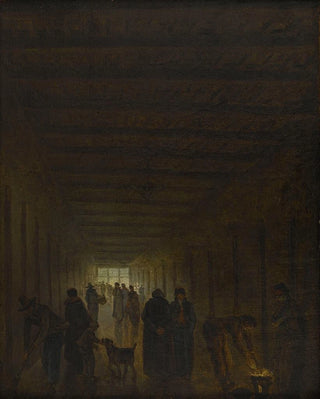Art print | Corridor of Saint-Lazare Prison - Hubert Robert


View from behind

Frame (optional)
In the fascinating world of art, some works stand out for their ability to evoke deep emotions and transport the viewer to bygone eras. "Art print of the corridor of Saint-Lazare prison - Hubert Robert" is one of these iconic pieces. Painted in the 18th century, it captures not only the essence of the architecture of its time but also the atmosphere of a place rich in history. The prison corridor, with its austere walls and subdued lighting, becomes the silent witness to lives that have crossed paths there. This work, both realistic and poetic, invites us to reflect on the human condition, solitude, and the quest for freedom.
Style and uniqueness of the work
Hubert Robert's style is characterized by an exceptional mastery of light and space. In "Art print of the corridor of Saint-Lazare prison," the artist manages to create an ambiance that is both oppressive and contemplative. Shadows dance on the walls, while light filters through narrow windows, emphasizing the contrast between hope and melancholy. Architectural details, such as columns and arches, are rendered with remarkable precision, demonstrating Robert's meticulous attention to the environment he depicts. This work is not limited to a simple representation of a place; it evokes an atmosphere, a story, a memory. Thus, the viewer is invited to immerse themselves in this enclosed space, to feel the prisoners' anxiety, and to contemplate the tragic beauty of their situation.
The artist and his influence
Hubert Robert, often considered the painter of ruins and landscapes, knew how to leave his mark on his era through his unique approach to architecture and nature. Born in 1733 in Paris, he was influenced by the neoclassical movement and developed a style that blends realism with romantic sensitivity. His work, beyond mere representation, seeks to establish a dialogue between man and his environment. By painting places rich in history, such as Saint-Lazare prison, Robert reminds us of the importance of collective memory and storytelling.

Matte finish

View from behind

Frame (optional)
In the fascinating world of art, some works stand out for their ability to evoke deep emotions and transport the viewer to bygone eras. "Art print of the corridor of Saint-Lazare prison - Hubert Robert" is one of these iconic pieces. Painted in the 18th century, it captures not only the essence of the architecture of its time but also the atmosphere of a place rich in history. The prison corridor, with its austere walls and subdued lighting, becomes the silent witness to lives that have crossed paths there. This work, both realistic and poetic, invites us to reflect on the human condition, solitude, and the quest for freedom.
Style and uniqueness of the work
Hubert Robert's style is characterized by an exceptional mastery of light and space. In "Art print of the corridor of Saint-Lazare prison," the artist manages to create an ambiance that is both oppressive and contemplative. Shadows dance on the walls, while light filters through narrow windows, emphasizing the contrast between hope and melancholy. Architectural details, such as columns and arches, are rendered with remarkable precision, demonstrating Robert's meticulous attention to the environment he depicts. This work is not limited to a simple representation of a place; it evokes an atmosphere, a story, a memory. Thus, the viewer is invited to immerse themselves in this enclosed space, to feel the prisoners' anxiety, and to contemplate the tragic beauty of their situation.
The artist and his influence
Hubert Robert, often considered the painter of ruins and landscapes, knew how to leave his mark on his era through his unique approach to architecture and nature. Born in 1733 in Paris, he was influenced by the neoclassical movement and developed a style that blends realism with romantic sensitivity. His work, beyond mere representation, seeks to establish a dialogue between man and his environment. By painting places rich in history, such as Saint-Lazare prison, Robert reminds us of the importance of collective memory and storytelling.






